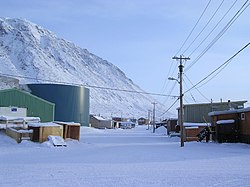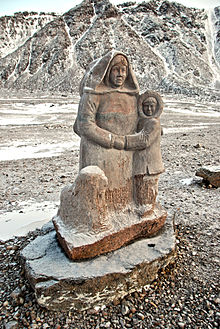Grise Fiord
Grise Fiord
ᐊᐅᔪᐃᑦᑐᖅ Aujuittuq | |
|---|---|
 | |
| Country | Canada |
| Territory | Nunavut |
| Region | Qikiqtaaluk Region |
| Electoral district | Quttiktuq |
| Settled | 1953 |
| Government | |
| • Mayor | Meeka Kigutak |
| • MLA | Ron Elliott |
| Area | |
| • Total | 332.7 km2 (128.5 sq mi) |
| Elevation | 41 m (135 ft) |
| Population (2011)[3] | |
| • Total | 130 |
| • Density | 0.39/km2 (1.0/sq mi) |
| Time zone | UTC-5 (EST) |
| • Summer (DST) | UTC-4 (EDT) |
| Canadian Postal code | |
| Area code | 867 |
| Website | www.grisefiord.ca |
Grise Fiord, (Inuktitut: Aujuittuq, "place that never thaws"; Inuktitut syllabics: ᐊᐅᔪᐃᑦᑐᖅ) is a small Inuit hamlet in the Qikiqtaaluk Region in the territory of Nunavut, Canada. Despite its low population (130 residents as of the Canada 2011 Census[3]), it is the largest community on Ellesmere Island. It is also one of the coldest inhabited places in the world, with an average yearly temperature of −16.5 °C (2.3 °F).
Geography
Located at the southern tip of Ellesmere Island, Grise Fiord is one of three permanent settlements on the island. Grise Fiord lies 1,160 km (720 mi) north of the Arctic Circle.

Grise Fiord is the northernmost civilian settlement in Canada, but was eclipsed by Alert, 800 km (500 mi) further north, as North America's northernmost community when Environment Canada and the Canadian Forces began to station permanent personnel there. The only other settlement on Ellesmere Island is Eureka, a small research base on Fosheim Peninsula.
Grise Fiord lies in the Arctic Cordillera mountain range.
Naming
Grise Fiord means "pig inlet" in Norwegian and was named by Otto Sverdrup from Norway during an expedition around 1900. He thought the walrus in the area sounded like pigs. Grise Fiord's Inuktitut name is Aujuittuq which means "place that never thaws."
Living conditions
The population of Grise Fiord consists of about 150 permanent residents. The houses are wooden and built on platforms to cope with the freezing and thawing of the permafrost. Hunting is still an important part of the lifestyle of the mostly Inuit population. Quota systems allow the villagers to supply many of their needs from populations of seals, walruses, narwhal and beluga whales, polar bears and musk oxen. Ecotourism is developing as people come to see the spectacular northern wildlife found on Ellesmere and surrounding islands.[5]
Transportation
There are no major highways on Ellesmere Island, so Grise Fiord is connected to the rest of the island and the world by Grise Fiord Airport. For local travel needs, the villagers use motorcycles and all terrain vehicles in the summer and snowmobiles in the winter. Boats are also used to bring supplies and travel around the fiord. Sea kayaking is a popular local sport.
Crime and safety

A Simon Fraser University study of Royal Canadian Mounted Police (RCMP) activity in the Baffin Region states that Grise Fiord had the lowest rate of criminal offences of all communities looked at in 1992,[6] and cites a 1994 Statistics Canada survey that gives the highest perception of personal safety.[7]
Climate
The climate in Grise Fiord is cold. Grise Fiord has an Arctic climate, which means that there is less than 250 mm (10 in) precipitation, and temperature stays below 0 °C (32 °F) for ten months of the year. The record low was −62.2 °C (−80.0 °F). It has an average yearly temperature of −16.5 °C (2.3 °F).
| Climate data for Grise Fiord airport | |||||||||||||
|---|---|---|---|---|---|---|---|---|---|---|---|---|---|
| Month | Jan | Feb | Mar | Apr | May | Jun | Jul | Aug | Sep | Oct | Nov | Dec | Year |
| Record high °C (°F) | −3 (27) |
−6 (21) |
−1 (30) |
0 (32) |
5 (41) |
14 (57) |
22 (72) |
17 (63) |
9 (48) |
−1 (30) |
−2 (28) |
−4 (25) |
22 (72) |
| Mean daily maximum °C (°F) | −30 (−22) |
−31 (−24) |
−28 (−18) |
−19 (−2) |
−8 (18) |
−1 (30) |
4 (39) |
3 (37) |
−1 (30) |
−9 (16) |
−19 (−2) |
−28 (−18) |
−13.9 (7.0) |
| Daily mean °C (°F) | −33 (−27) |
−34 (−29) |
−31 (−24) |
−22 (−8) |
−10 (14) |
−3 (27) |
2 (36) |
1 (34) |
−4 (25) |
−12 (10) |
−22 (−8) |
−30 (−22) |
−16.5 (2.3) |
| Mean daily minimum °C (°F) | −36 (−33) |
−37 (−35) |
−34 (−29) |
−25 (−13) |
−12 (10) |
−5 (23) |
0 (32) |
−1 (30) |
−7 (19) |
−15 (5) |
−25 (−13) |
−32 (−26) |
−19.1 (−2.4) |
| Record low °C (°F) | −62.1 (−79.8) |
−59.5 (−75.1) |
−52.4 (−62.3) |
−43.3 (−45.9) |
−30.2 (−22.4) |
−19.1 (−2.4) |
−7.2 (19.0) |
−8.1 (17.4) |
−23.6 (−10.5) |
−34.8 (−30.6) |
−47.5 (−53.5) |
−52.2 (−62.0) |
−62 (−80) |
| Source: Environment Canada | |||||||||||||
History
Settlement

The settlement (and Resolute) was created by the Canadian government in 1953, partly to assert sovereignty in the High Arctic during the Cold War. Eight Inuit families from Inukjuak, Quebec (on the Ungava Peninsula) were relocated after being promised homes and game to hunt, but the relocated people discovered no buildings and very little familiar wildlife.[8] They were told that they would be returned home after a year if they wished, but this offer was later withdrawn as it would damage Canada's claims to sovereignty in the area and the Inuit were forced to stay. Eventually, the Inuit learned the local beluga whale migration routes and were able to survive in the area, hunting over a range of 18,000 km2 (6,900 sq mi) each year.[9]
In 1993, the Canadian government held hearings to investigate the relocation program. The Royal Commission on Aboriginal Peoples issued a report entitled The High Arctic Relocation: A Report on the 1953-55 Relocation, recommending a settlement.[10] The government paid $10 million CAD to the survivors and their families, and gave a formal apology in 2008.[11]

In 2009, Looty Pijamini was commissioned by the Canadian Government to design a monument in memory of the relocation.[12] Depicting a sad-looking woman with a young boy and a husky, the monument was unveiled by John Duncan, Minister of Indian Affairs and Northern Development and Federal Interlocutor for Métis and Non-Status Indians, on September 10, 2010.[13][14]
Telephone network
In 1970, Bell Canada established what was then the world's most northerly telephone exchange (operated since 1992 by Northwestel).
Whooping cough epidemic
On November 1, 1960, at 2:00 am the R.C.M.P. reported that a seven-month old Inuit baby had died from whooping cough and dozens of other children were affected at Grise Fjord. "All red tape was obliterated and within an hour 40-year-old Dr. A. H. Stevens ... was getting ready for his mercy flight 2,200 miles north of Ottawa, and about 700 miles inside the Arctic Circle." F/L (Flight Lieutenant) Al Richards flew the R.C.A.F. C-47 Dakota (U.S. designation Douglas C-47 Skytrain) from Trenton out of Ottawa's Uplands Airport. "The plane made its way north during most of Nov. 5 until it hit a violent Arctic blizzard and developed mechanical trouble. ... F/L Richards decided to make an emergency landing. ... in the blinding storm the Dakota, with Dr. Stevens aboard, managed to land at the small airfield at Great Whale Bay." After repairs they flew on the next day to Resolute Bay. "The RCMP post near the village (of Grise Fjord) reported that two other Eskimo babies were in critical condition ... Dr. Stevens had to fly from Resolute Bay to Grise Fjord in a two-seater Piper Super Cub Piper PA-18.[15] It was flown by Welland Phipps of Almonte, Ontario." He was known as Weldy Phipps, call-sign Whiskey Whiskey Papa, a top Canadian "bush pilot." The aircraft heater failed enroute and the pilot and doctor nearly froze to death. Then there was a 6-mile dogsled ride in the dark of the winter for the doctor to Grise Fjord.[16] "Upon arrival at Grise Fjord the doctor got down to work straight away ... He stayed there a number of days and cured all whooping cough cases. On the way back from Grise Fjord Dr. Stevens got a message that Mike Kczub, the 25-year-old commander of the Radiosonde station at Coral Harbour had been taken seriously ill. The Dakota mercy plane was diverted." Mr. Kczub was brought to Ottawa for treatment. Dr. Arnott Hume MacGregor Stevens, known to everyone including his parents as Dr. Pete Stevens, was born in 1919. He died in Vancouver, B.C. in October, 1985. Quotes are from undated November 1960 newspaper clipping from an unidentified newspaper.[17][18]
On September 18, 2006, Florin Fodor, a citizen of Romania, arrived at Grise Fiord in a 20 ft (6.1 m) fiberglass boat that he had purchased in Sisimiut, Greenland. He had spent eight days at sea and was almost out of food, and had only five litres of fuel left.[19][20] Fodor pled guilty in November 2006 to two charges of violating Canada's Immigration Act.[21] He was sentenced to seven and half months of detention. Justice Lise Maisonneuve ruled that Fodor should be deported when his sentence was complete.[22]
Gallery
References
- ^ Northern News Services (2008-12-10). "Hamlets elect new councils". Nnsl.com. Retrieved 2013-01-10.
- ^ "Election Results - 2008 General Election". Elections.nu.ca. Retrieved 2013-01-10.
- ^ a b c "Census Profile - Census subdivision". 2.statcan.gc.ca. 2012-11-02. Retrieved 2013-02-28.
- ^ Elevation at airport. Canada Flight Supplement. Effective 0901Z 16 July 2020 to 0901Z 10 September 2020.
- ^ Grise Fiord: Wildlife
- ^ Curt Taylor Griffiths, Gregory Saville, Darryl S. Wood, and Evelyn Zellerer. POLICING THE BAFFIN REGION, N.W.T.: Findings From the Eastern Arctic Crime and Justice Study, 1995 [1]
- ^ "Aboriginal Peoples Survey", Statistics Canada, 1994, cited on p17 of Curt Taylor Griffiths, Gregory Saville, Darryl S. Wood, and Evelyn Zellerer, POLICING THE BAFFIN REGION, N.W.T.: Findings From the Eastern Arctic Crime and Justice Study [2]
- ^ "Grise Fiord: History". Grisefiord.ca. Retrieved 2013-01-10.
- ^ McGrath, Melanie. The Long Exile: A Tale of Inuit Betrayal and Survival in the High Arctic. Alfred A. Knopf, 2006 (268 pages) Hardcover: ISBN 0-00-715796-7 Paperback: ISBN 0-00-715797-5
- ^ The High Arctic Relocation: A Report on the 1953-55 Relocation by René Dussault and George Erasmus, produced by the Royal Commission on Aboriginal Peoples, published by Canadian Government Publishing, 1994 (190 pages)[3]
- ^ Royte, Elizabeth (2007-04-08). "Trail of Tears". The New York Times.
{{cite news}}: Cite has empty unknown parameter:|coauthors=(help) - ^ "Carvers chosen for Arctic monuments", Northern News Services. Retrieved 1 June 2011.
- ^ "Minister Duncan Attends Unveiling of Inuit Relocation Monuments", Indian and Northern Affairs Canada. Retrieved 1 June 2011.
- ^ Gabriel Zarate, "For Grise Fiord’s exiles, an apology that came too late", Nunatsiaq Online. Retrieved 1 June 2011.
- ^ Super Cub Bush Planes
- ^ "Whiskey Whiskey Papa" by Norman Avery pp. 81-83
- ^ Undated November 1960 newspaper clipping from an unidentified newspaper in the possession of Dr. A. H. Stevens' eldest son, Colin MacGregor Stevens, Richmond, B.C.
- ^ Reader's Digest (Canadian Edition) February 1971 pp. 40-45 "Whiskey Whiskey Papa: Highest Flier in the High Arctic" 1998 by Lawrence Elliott.
- ^ "Romanian who boated to High Arctic fesses up". CBC News. 2006-11-15. Retrieved 2008-08-10. mirror
- ^ "Grise Fiord "refugee" to court". Siku News. 2006-11-12. Retrieved 2008-08-10. mirror
- ^ "Jail for border hopper". Siku News. 2006-11-22. Retrieved 2008-08-10. mirror
- ^ Paula McCooey (2006-11-21). "Man who tried to enter Canada by boat gets jail sentence". Ottawa Citizen. Retrieved 2008-08-04. mirror








